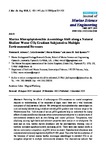Marine Microphytobenthic Assemblage Shift along a Natural Shallow-Water CO2 Gradient Subjected to Multiple Environmental Stressors
| dc.contributor.author | Johnson, V | |
| dc.contributor.author | Brownlee, C | |
| dc.contributor.author | Milazzo, M | |
| dc.contributor.author | Hall-Spencer, Jason | |
| dc.date.accessioned | 2016-02-08T13:44:47Z | |
| dc.date.available | 2016-02-08T13:44:47Z | |
| dc.date.issued | 2015-12-01 | |
| dc.identifier.issn | 2077-1312 | |
| dc.identifier.issn | 2077-1312 | |
| dc.identifier.uri | http://hdl.handle.net/10026.1/4283 | |
| dc.description.abstract |
Predicting the effects of anthropogenic CO2 emissions on coastal ecosystems requires an understanding of the responses of algae, since these are a vital functional component of shallow-water habitats. We investigated microphytobenthic assemblages on rock and sandy habitats along a shallow subtidal pCO2 gradient near volcanic seeps in the Mediterranean Sea. Field studies of natural pCO2 gradients help us understand the likely effects of ocean acidification because entire communities are subjected to a realistic suite of environmental stressors such as over-fishing and coastal pollution. Temperature, total alkalinity, salinity, light levels and sediment properties were similar at our study sites. On sand and on rock, benthic diatom abundance and the photosynthetic standing crop of biofilms increased significantly with increasing pCO2. There were also marked shifts in diatom community composition as pCO2 levels increased. Cyanobacterial abundance was only elevated at extremely high levels of pCO2 (>1400 μatm). This is the first demonstration of the tolerance of natural marine benthic microalgae assemblages to elevated CO2 in an ecosystem subjected to multiple environmental stressors. Our observations indicate that Mediterranean coastal systems will alter as pCO2 levels continue to rise, with increased photosynthetic standing crop and taxonomic shifts in microalgal assemblages. | |
| dc.format.extent | 1425-1447 | |
| dc.language | en | |
| dc.language.iso | en | |
| dc.publisher | MDPI AG | |
| dc.subject | 14 Life Below Water | |
| dc.title | Marine Microphytobenthic Assemblage Shift along a Natural Shallow-Water CO2 Gradient Subjected to Multiple Environmental Stressors | |
| dc.type | journal-article | |
| dc.type | Journal Article | |
| plymouth.issue | 4 | |
| plymouth.volume | 3 | |
| plymouth.publication-status | Published online | |
| plymouth.journal | Journal of Marine Science and Engineering | |
| dc.identifier.doi | 10.3390/jmse3041425 | |
| plymouth.organisational-group | /Plymouth | |
| plymouth.organisational-group | /Plymouth/Faculty of Science and Engineering | |
| plymouth.organisational-group | /Plymouth/Faculty of Science and Engineering/School of Biological and Marine Sciences | |
| plymouth.organisational-group | /Plymouth/PRIMaRE Publications | |
| plymouth.organisational-group | /Plymouth/REF 2021 Researchers by UoA | |
| plymouth.organisational-group | /Plymouth/REF 2021 Researchers by UoA/UoA07 Earth Systems and Environmental Sciences | |
| plymouth.organisational-group | /Plymouth/Research Groups | |
| plymouth.organisational-group | /Plymouth/Research Groups/Marine Institute | |
| plymouth.organisational-group | /Plymouth/Users by role | |
| plymouth.organisational-group | /Plymouth/Users by role/Academics | |
| dc.identifier.eissn | 2077-1312 | |
| dc.rights.embargoperiod | Not known | |
| rioxxterms.versionofrecord | 10.3390/jmse3041425 | |
| rioxxterms.licenseref.uri | http://www.rioxx.net/licenses/all-rights-reserved | |
| rioxxterms.type | Journal Article/Review | |
| plymouth.oa-location | http://www.mdpi.com/2077-1312/3/4/1425/htm |


